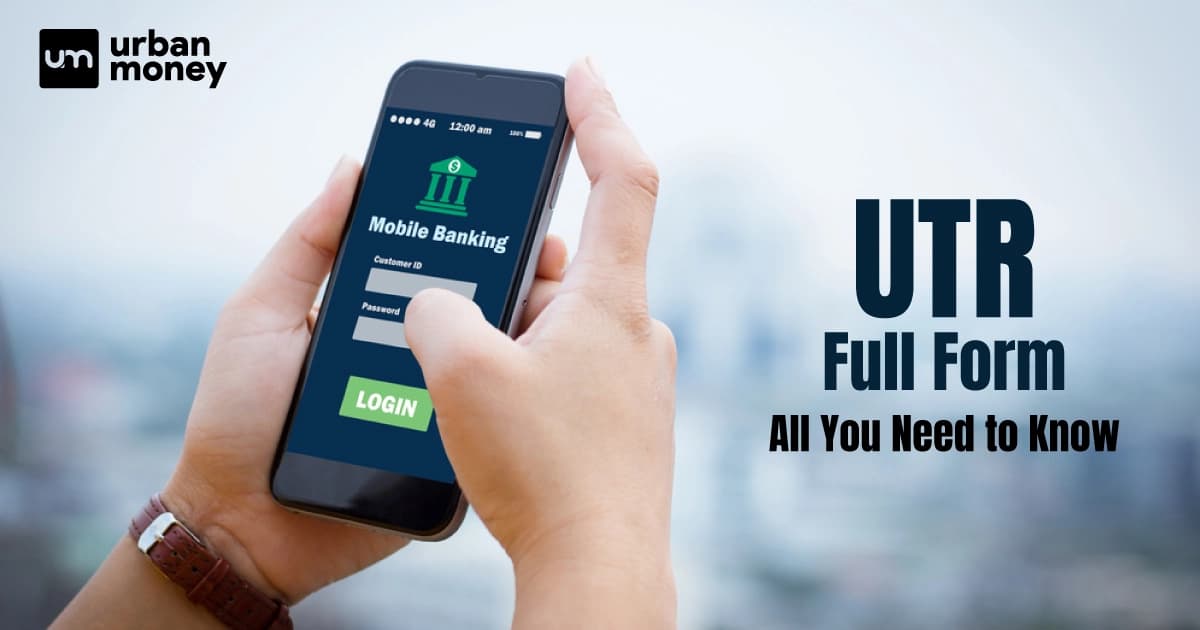UTR Number Full Form: Format of UTR Code, Meaning

- Personalized solutions
- Expert guidance
- Application assistance
- Credit score discussion
- Interest rate comparison
Table of Content


Last Updated: 29th April 2025
‘We’re sorry, the transaction you are trying to make has been put on hold’, ‘Your transaction couldn’t take place because our servers are going through some maintenance work’. Although common bank transaction notifications, these can be really annoying. Ever wondered how these bank transactions take place? Let us tell you that behind every transaction is a UTR working diligently so that we can do our work seamlessly. Yes, in the universe of banking transactions, UTR plays a significant role. And this is exactly what we are going to discuss today. So, without any delay, let’s get started and know more about UTR full form, its structure, significance and more.
What is the Full Form of UTR?
The full form of UTR is Unique Transaction Reference. Fundamentally, it is nothing but a unique identifier that ensures every banking transaction can be pinpointed and also differentiated from millions of other banking transactions that happen across the entire banking system. Whether it’s transferring money from one bank account to another, sending money overseas, or making payments via online banking, every transaction requires a specific identification code. This is where UTR comes into play. In terms of uniqueness, traceability, efficiency, and security, UTR is foolproof.
Format of UTR Code
Understanding the format of UTR is quite important. Let’s throw some light on the format of UTR code.
Structure of the UTR Code
Depending upon the bank, UTR code’s length as well as format can vary. However, in many cases, the UTR code follows a consistent pattern:
In Terms of Length: These codes are majorly composed of 6-16 alphanumeric characters.
Components of UTR Code: The UTR might be a mix of:
- Bank Identifier: It is one of the major components of UTR code. This code is usually unique to the bank from where the transaction is originating.
- Date: The date of transaction is always integrated into the UTR, either as a complete date or as a shorthand version.
- Sequence Number: The third most important component of UTR is a unique number that follows in sequence with other transactions right from that particular day or period.
- Alphanumeric Nature: A UTR code can be made up entirely of numbers or a mix of numbers or letters.
UTR Meaning in Banking
As the name suggests, UTR is a specific reference number or code assigned to every transaction that is processed through the bank. It won’t be an understatement to say that UTR is the backbone of the banking system.
Roles and Significance of UTR in Banking
- Identification: The very basic and primary function of the UTR is to serve as an identification marker. Because of the presence of UTR each transaction can be individually recognized and separated from other transactions.
- Traceability: With UTR, it is possible to trace any transaction back to its source while being able to verify its details.
- Reconciliation: The UTRs also play a key role in the process of reconciliation. It ensures that every transaction that has taken place matches the bank statements with company records.
- Dispute Resolution: UTR also serves as the very first point of reference in case of discrepancies or any kind of disagreements.
- Enhanced Security: A UTR signifies that a transaction has been processed and acknowledged by the banking system. It acts as a deterrent for any kind of fraudulent activities since every transaction can be traced and is also accountable.
Integration with Other Banking Systems
The UTR system doesn’t exist in isolation. It’s integrated with various other banking systems like:
- RTGS (Real Time Gross Settlement): Used for high-value transactions, where the UTR ensures that every significant transaction is meticulously tracked.
- NEFT (National Electronic Funds Transfer): A system for transferring funds between banks where UTRs play a vital role in ensuring the traceability of every single transaction.
- IMPS (Immediate Payment Service): Enables instant money transfer.
How Do UTR Numbers Work?
Let’s try and understand how these unique sets of numbers work.
Generation of UTR Numbers
- Initiation of Transaction: Whenever a banking transaction is initiated, be it a funds transfer, payment processing, or any other electronic transaction, the system starts the process of generating a UTR number.
- Unique Assignment: The bank’s system or the central banking system (depending on the country or the type of transaction) assigns a unique code to that specific transaction.
- Incorporation of Details: The UTR may often encapsulate details like the transaction date or the bank’s identifier, among others, depending on its format.
Utilisation of UTR Numbers
- Transaction Tracking: Once generated, the UTR number accompanies the transaction through every step of its journey. Whether the transaction is in a queue awaiting processing, has been successfully completed, or has encountered an error, the UTR remains attached to it, allowing for easy tracking.
- Verification and Reconciliation: Businesses and individuals can use the UTR number to verify transactions with their bank. If they spot any discrepancies in their financial records, the UTR serves as the primary reference point to resolve them.
- Dispute Resolution: In cases of disputes or concerns about specific transactions, banks will often ask customers for the UTR number. This practice allows them to quickly locate the transaction in their respective systems while addressing the customer’s concerns.
Post-Transaction Activities
- Statement Reflection: On bank statements or transaction receipts, one will often find the UTR number listed alongside transaction details. This allows account holders to match their records with bank statements.
- Customer Queries: Should customers have any questions or concerns about a transaction, they can reference the UTR number when contacting their bank. This expedites the query resolution process.
- Audit and Compliance: From a bank’s perspective, UTR numbers are invaluable during audit processes. With the help of UTR, a number can be easily verified thus, ensuring compliance with financial regulations.
Who Generates the UTR number?
The full form of UTR in banking is Unique Transaction Reference (UTR). This number is a critical component in the banking and financial sectors, ensuring the traceability and uniqueness of each transaction. But where does it come from? Who is responsible for generating this unique identifier? Let’s understand.
- Bank-to-Bank Transfers: When you initiate a fund transfer from one bank to another, the sending bank (the bank from which the money is being sent) usually generates the UTR number. This ensures that the originating bank has a record and reference of every transaction initiated from its system.
- Centralised Banking Systems: In some countries, centralised systems or organisations handle specific types of transactions. For instance, in India, the National Payments Corporation of India (NPCI) oversees UPI (Unified Payments Interface) and IMPS (Immediate Payment Service) transactions. For such centralised systems, the UTR might be generated by the central entity rather than the individual bank.
- Cross-border Transactions: For international fund transfers, the UTR can be generated by the originating bank, intermediary banks (if involved), or by the platform facilitating the transfer, depending on the protocols of the system in place.
- Algorithmic Generation: The UTR number is not generated manually but is the result of an algorithmic process. This system ensures:
- Uniqueness: No two transactions will ever have the same UTR number. Even if the same two parties transact the exact amount repeatedly, each transaction will have a distinct UTR.
- Timely Generation: Given the high volume of transactions processed every second, the UTR generation process is swift, ensuring that there’s no delay in transaction processing.
- Link with Transaction Details: The UTR number, once generated, is intrinsically linked with the transaction’s details. This means that when the UTR is referenced, it provides access (to authorised entities) to all details of the transaction, such as the parties involved, the amount, the date and time of the transaction, and more.
Where Can I Find the UTR number?
For the unversed, the full form of UTR is Unique Transaction Reference. Once generated, the UTR number acts as a ticket, accompanying a transaction through every phase of its processing. But if you’re on the lookout for a UTR number for a transaction you’ve made or received, where exactly should you look? Let’s explore.
- Bank Statements: One of the most straightforward places to find a UTR number is on your bank statement. Whether you receive a monthly paper statement in the mail or access your statements online through internet banking, every transaction listed will typically have a reference number, which in many cases will be the UTR.
- Transaction Receipts: If you’ve made a transaction at a bank branch, such as a wire transfer or a deposit, you’d usually receive a receipt for the same with detailed information about the transaction.
- Mobile and Internet Banking: Most banks offer mobile and internet banking services. When you make or receive a transaction using these platforms:
- Transaction History: Log into your bank’s mobile or web application. In the transaction history or statement section, every transaction will typically have associated details which are inclusive of the UTR.
- Transaction Notifications: There are many banking apps which send instant notifications for transactions. These notifications often contain important details which is inclusive of UTR number.
- SMS Alerts: There are many banks which also offer SMS alert. And if you have opted for this service, you might get a SMS every time there’s a transaction on your account. And depending upon your bank’s SMS format, the UTR number might be included in this message.
- Contacting Your Bank: If in case, you are unable to locate the UTR number or unable to verify it, you can always call your bank’s customer service hotline. They could help you retrieve the UTR.
- Visit a Branch: You can also consider visiting your branch or speaking to a representative for retrieving the UTR number.
- Ask the Sender: The individual or entity sending the funds can offer you with UTR number once they have initiated the transaction from their end.
Why Do I Need a UTR number?
A UTR might seem like a normal set of numbers initially, however, its overall significance in the financial world is profound. Let’s try and understand why it is an important number and why you would need it through its benefits and limitations. Here’s a quick snapshot of the benefits and limitations of UTR.
|
UTR (Unique Transaction Reference) |
Benefits of UTR | Limitations of UTR |
| – Uniqueness ensures every transaction can be easily traced. | – Dependent on banking infrastructure. | |
| – Universality across most banks and financial institutions. | – Lacks a standardised format across different banks or institutions. | |
| – Efficient in resolving transactional disputes. | – Is a tracking tool, not a security feature in itself. | |
| – Enhances security by facilitating the monitoring of transactions. | – Limited to specific types of transactions (mainly bank-related). | |
| – Assists in maintaining regulatory compliance and a transparent audit trail. | – Effective management is required for optimal use. |
UTR vs.Other Tracking Methods
Following is the basic snapshot of the UTR vs. Other tracking methods:
| Tracking Method | Advantages | Limitations |
| UTR (Unique Transaction Reference) | – Uniqueness ensures easy traceability.
– Universality across banks and financial institutions. – Efficient in resolving disputes. |
– Dependency on banking infrastructure.
– Lacks standardisation across different institutions. |
| Transaction IDs | – Platform-specific, independent of banks.
– Consistent format within the platform. |
– Limited to specific platforms or merchants.
– Might need cross-referencing with banks. |
| Reference Numbers | – Simplicity in format.
– Beneficiary-driven, allowing them to set their tracking. |
– Not unique for every transaction.
– Limited information compared to UTRs. |
| Invoice Numbers | – Clear record tied to goods/services.
– Businesses have control over their system and format. |
– Mainly for credit transactions.
– Might need cross-referencing with bank transactions. |
| QR Codes | – Versatile with high information storage.
– Ease of use with just a scan. |
– Requires technology (e.g., smartphone). – Might lack UTR’s traceability in traditional banking. |
Frequently Asked Questions (FAQs)
How can I format my 16 digit UTR number for NEFT?
If you’ve received or been provided with a 16-digit UTR number for NEFT, you typically do not need to format it in any special way. The UTR should be used as-is. However, always ensure that you enter the UTR without any spaces or special characters.
Is UTR and UPI the same?
No, UTR and UPI are not the same. UTR is a unique set of characters or numbers assigned to identify a particular transaction. On the other hand, UPI (Unified Payments Interface) is a real-time payment system developed by the National Payments Corporation of India, which facilitates inter-bank transactions by instantly transferring funds between two bank accounts on a mobile platform.
Can we share a UTR number with anyone?
As a UTR number doesn’t contain any sensitive information, it can be shared to others.
Why would someone want my UTR number?
If in case, someone wants to verify and confirm a transaction, a UTR number can be of great help. Not just it helps in verifying a bank transaction, one can also cross-check it with the respective bank.
What is UTR no and how to get it for IMPS fund transfer?
UTR full form is Unique Transaction Reference. As far as IMPS is concerned, the UTR number is generated once the transaction is initiated. One can easily find a UTR number in their bank statement, transaction receipt or even SMS notification.
Which bank generates a 12 digit UTR number starting with c?
The format of UTRs can differ from bank to bank. Thus, it is important to directly consult with the respective bank or check their official documentation for the specifics.
What is the full form of UTR and URL?
The full form of UTR is Unique Transaction Reference and the full form of the URL is Uniform Resource Locator.
What is the UTR number in a UPI transaction?
In a UPI transaction, the UTR number serves the same primary purpose of identifying the transaction. Once the UPI transaction is initiated, a UTR number is generated and can be found in the transaction details. One can check it in the mobile banking app or UPI app from where the transaction was made in the first place.
